Plurinational State of Bolivia
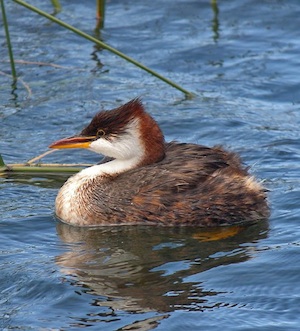
Bolivia is a landlocked country located in western-central South America. It is bordered by Brazil to the north and east, Paraguay to the southeast, Argentina to the south, Chile to the southwest, and Peru to the west. The seat of government and administrative capital is La Paz, which contains the executive, legislative, and electoral branches of government, while the constitutional capital is Sucre, the seat of the judiciary. The largest city with almost two million inhabitants and the principal industrial centre is Santa Cruz de la Sierra, located on the Llanos Orientales (eastern tropical lowlands), a mostly flat region in the east of the country. Its geography varies as the elevation fluctuates, from the western snow-capped peaks of the Andes to the eastern lowlands, situated within the Amazon basin. One-third of the country is within the Andean mountain range. With an area of 1,098,581 km2 (424,164 square miles), Bolivia is the fifth-largest country in South America after Brazil, Argentina, Peru and Colombia, and, alongside Paraguay, is one of just two landlocked countries in the Americas. It has a multi-ethnic population of about 14.5 million people.
The geography of the country exhibits a great variety of terrain and climates. Bolivia has a high level of biodiversity, considered one of the greatest in the world, as well as several eco-regions with ecological sub-units such as the Altiplano, tropical rainforests (including Amazon rainforest), dry valleys, and the Chiquitania, which is a tropical savanna. These areas feature enormous variations in altitude, from an elevation of 21,463 feet above sea level in Nevado Sajama to 230 feet along the Paraguay River.
Bolivia can be divided into three physiographic regions:
The Andean region in the southwest spans 28% of the national territory, extending over 307,603 square kilometres. This area is located above 3,000 meters altitude and is located between two big Andean chains, the Cordillera Occidental and the Cordillera Central, with some of the highest spots in the Americas. Located in the Cordillera Central is Lake Titicaca, the highest commercially navigable lake in the world and the largest lake in South America; the lake is shared with Peru. Also in this region are the Altiplano and the Salar de Uyuni, which is the largest salt flat in the world and an important source of lithium.]
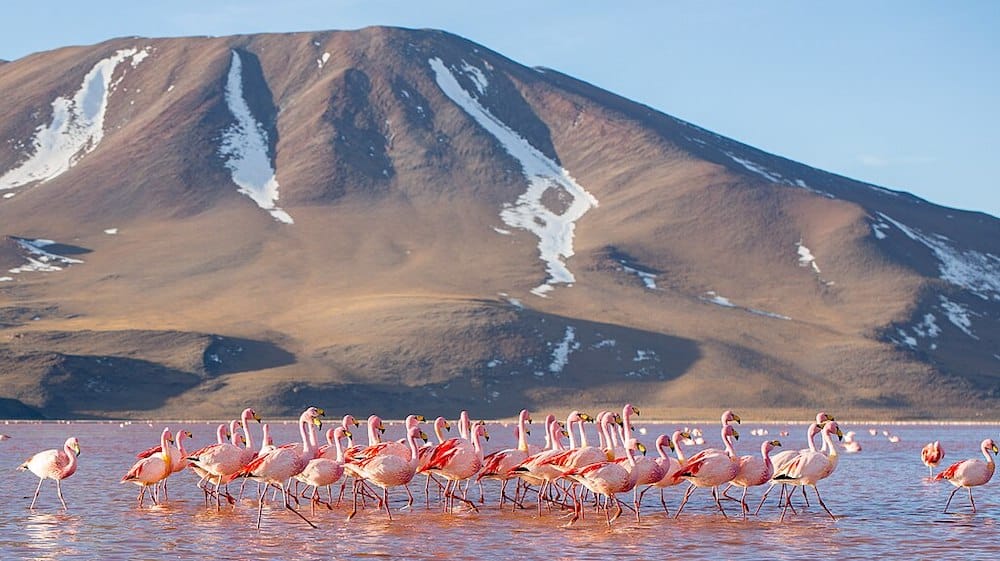
James’s Flamingoes in Laguna Colorada – ©Havardtl, CC BY-SA 4.0 via Wikimedia Commons
The Sub-Andean region in the centre and south of the country is an intermediate region between the Altiplano and the eastern llanos (plain); this region comprises 13% of the territory of Bolivia, extending over 142,815 km2 and encompassing the Bolivian valleys and the Yungas region. It is distinguished by its farming activities and its temperate climate.
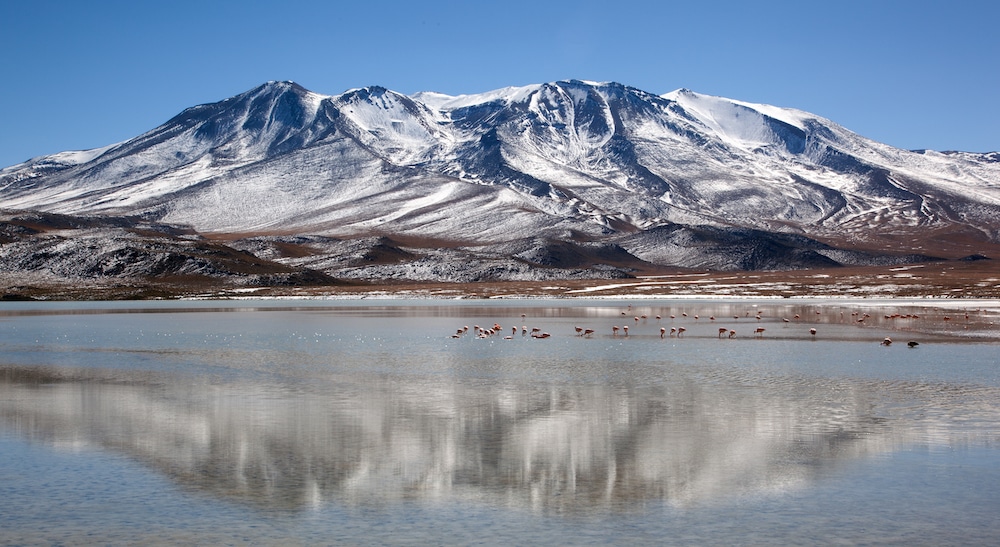
Laguna Hedionda – © Dan Lay
The Llanos region in the northeast comprises 59% of the territory, covering 648,163 km2. It is located to the north of the Cordillera Central and extends from the Andean foothills to the Paraguay River. It is a region of flat land and small plateaus, all covered by extensive rain forests containing enormous biodiversity. The region is below 400 meters above sea level.
The climate of Bolivia varies drastically from one eco-region to the other, from the tropics in the eastern llanos to a polar climate in the western Andes. The summers are warm, humid in the east and dry in the west, with rains that often modify temperatures, humidity, winds, atmospheric pressure and evaporation, yielding very different climates in different areas. When the climatological phenomenon known as El Niño takes place, it causes great alterations in the weather. Winters are very cold in the west, and it snows in the mountain ranges, while in the western regions, windy days are more common. The autumn is dry in the non-tropical regions.
The territory of Bolivia comprises four types of biomes, 32 ecological regions, and 199 ecosystems. Within this geographic area there are several natural parks and reserves such as the Noel Kempff Mercado National Park, the Madidi National Park, the Tunari National Park, the Eduardo Avaroa Andean Fauna National Reserve, and the Kaa-Iya del Gran Chaco National Park and Integrated Management Natural Area, among others.
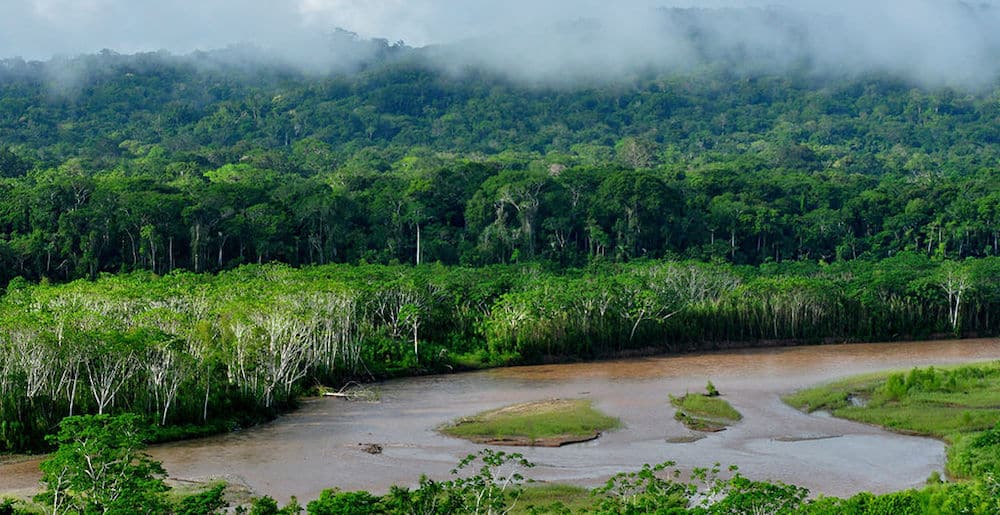
Madidi National Park – ©Dirk Embert / WWF, CC BY-SA 3.0 DE via Wikimedia Commons
Bolivia has more than 2,900 animal species, including 398 mammals, over 1,400 birds (about 14% of birds known in the world, being the sixth most diverse country in terms of bird species), 204 amphibians, 277 reptiles, and 635 fish and more than 3,000 types of butterfly
Birding Bolivia
Whatever mental images that you have of Bolivia, and get rid of them. Pretend that you have never even heard the name before. Now that you have no preconceptions I will try to put the pieces of a new jig-saw together to create a completely new picture of Bolivia for you.
First imagine hundreds of kilometres of hot and humid Rainforest with Parrots, Toucans, Ovenbirds and Antbirds abounding. File this in your archive. Now imagine a vast area of hot tropical, varied grasslands with palms trees, and river-edge tropical forest, and dry thorny forest patches. Imagine the Jabiru, Storks, Ibises, Ducks, and Herons in abundances beyond counting – they seem to be everywhere. Add 7 species of Macaw (including one of the world’s rarest Parrots and endemic to this region – the Blue-throated Macaw); Rheas and Crane Hawks. Now go southeast from these Semi-inundated Beni Pampas to the flooded marshes of the Pantanal, with its awesome Hyacinth Macaw. Here are Giant River Otters and marsh birds flitting through the reeds.
Now imagine these open areas flooded with Austral migrants from Argentina – massive mixed flocks of Seedeaters. Add to this image under our label Bolivia, a massive extension of dry Chiquitania forest, which spreads south to the open dry forests of the Chaco. And now, after covering 60% of the country we reach the Andes Mountains. Imagine yourself at the lowland base of the Andes, ready to slowly drive up the slope to experience the altitudinally arranged bird communities, from 500 to 1000m, to 1000m to 2000m, to 3000m to 3600m.

Los Yungas La Paz – ©Elias Bizannes CC BY-SA 2.0 via Wikimedia Commons
But before you start your climb you can see the humid wet yungas bird community, or would you rather climb the dry edge with cactus and scrub and highly adapted birds to these regions. Finally (and it should be the final part to any real visit to allow your body to adjust to the altitude changes) add cold, clear-air sites of the high Andean altiplano, the three flamingo species of Lake Ururo, and the Flightless Grebe of Lake Titicaca. And place on top of these images, the high altitude threatened Polylepis forests of Bolivia such as San Miguel with eight endemic species – creatures adapted to a species of tree that is going extinct as it is cut down for firewood.
Add to this habitat diversity, a gentle, kind diversity of people. A population of less than 15 million, Bolivia is still 80% undeveloped. Travel through indigenous cultures, many different local languages, clothes, faces and shapes adapted to the varying climates the country offers. Each new bird community holds a habitat change that adds a new dish to the local menu. High Andean cactus fruits down to Lowland tropical fruits like Chirimoya, Mango, Guineo, Leche de majo and many more.
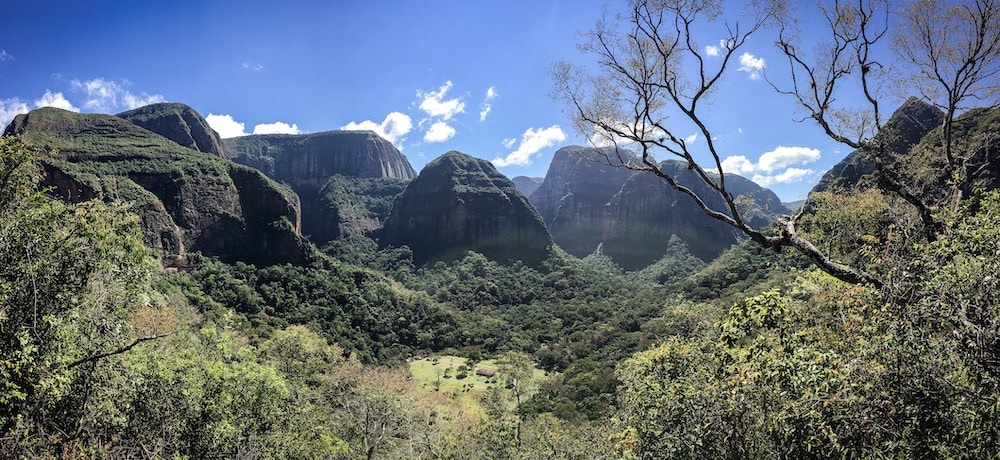
Refugio Los Volcanes – © Dan Lay
The Bolivian novice should first come for a sample trip. Beginning from the city of Santa Cruz, visiting the dry Andes, the temperate foothill forest, the dry forest and the open areas with Chaco influence of Santa Cruz’s city park Lomas de Arena. Fly to Cochabamba (middle height) to drive down the wettest Yungas of Bolivia, down, down into the hot heat. Go see the Oilbirds, and try to find a Cock-of-the-Rock. Spend a night in Cochabamba to head to the Polylepis forest in Tunari Park for a day – and don’t leave without seeing the Cochabamba Mountain-Finch – since that is the only place you can see it. Fly to La Paz, and spend a day at Lago Titicaca, and another few days back down Yungas. Fly to Trinidad and wow at the exaggerated abundances of these tropical open area birds. And then fly to Santa Cruz to finish the trip.
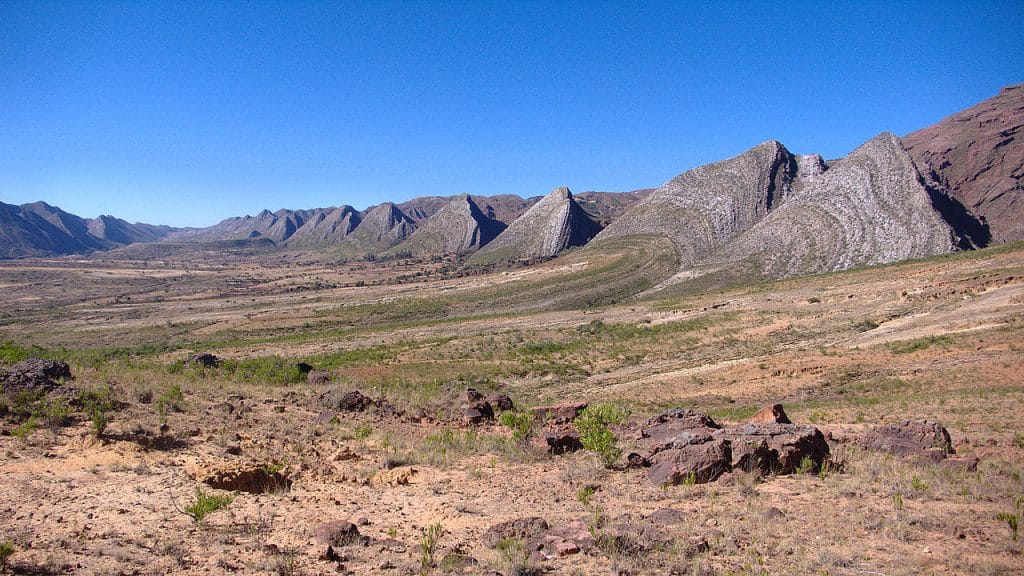
Torotoro National Park – ©Gaumut, CC BY-SA 3.0 via Wikimedia Commons
Bolivia is the ideal place to start to learn the birds of South America. After a trip in Bolivia, you will know all the major habitat types South America has to offer. For some the humidity is too much, for some the thin cold air is draining, for some the dry forest bugs are intolerable and for some it is all just beautiful.
-
A. Bennett Hennessey
Santa Cruz de la Sierra, Bolivia | Tangara@unete.com
http://www.birdbolivia.com
-
Number of bird species: 1447
(As at August 2024)National Bird Andean Condor Vultur gryphus
Number of endemics: 18
7 Non-passerines:
Horned Curassow Pauxi unicornis
Coppery Thorntail Thorntail Popelairia letitiae
Black-hooded Sunbeam Aglaeactis pamela
Bolivian Starfrontlet Coeligena violifer
Cliff Parakeet Myiopsitta luchsi
Blue-throated Macaw Ara glaucogularis
Red-fronted Macaw Ara rubrogenys
11 Passerines:
Masked Antpitta Hylopezus auricularis
Bolivian Earthcreeper Upucerthia harterti
Berlepsch's Canastero Asthenes berlepschi
Bolivian Spinetail Cranioleuca henricae
Black-throated Thistletail Schizoeaca harterti
Apolo Cotinga Phibalura boliviana
Unicolored Thrush Turdus haplochrous
Bolivian Blackbird Oreopsar bolivianus
Cochabamba Mountain-Finch Poospiza garleppi
Ringed Warbling-finch Microspingus torquatus
Grey-bellied Flower-piercer Diglossa carbonariaNumber of endemics: Some sources add 2 more:
Bolivian Antpitta Grallariacochabambae
Inti Tanager Heliothraupis oneilli
-
Avibase
PDF ChecklistThis checklist includes all bird species found in Bolivia , based on the best information available at this time. It is based on a wide variety of sources that I collated over many years. I am pleased to offer these checklists as a service to birdwatchers. If you find any error, please do not hesitate to report them. -
Birds of Bolivia
ListCompiled by: Sebastian K. Herzog, Scientific Director, Asociación Armonía (skherzog@armonia-bo.org) -
Wikipedia
Annotated ListThis is a list of the bird species recorded in Bolivia. The avifauna of Bolivia has 1408 confirmed species. Fifteen are endemic -
eBird
PDF ChecklistThis checklist is generated with data from eBird (ebird.org), a global database of bird sightings from birders like you. If you enjoy this checklist, please consider contributing your sightings to eBird. It is 100% free to take part, and your observations will help support birders, researchers, and conservationists worldwide.
-
An Annotated List of the Birds of Bolivia
| By JV Remsen & MA Taylor | Harrell Books | 1989 | Paperback | 79 pages, Tabs, maps | ISBN: 9780931130168 Buy this book from NHBS.com -
Birds of Bolivia Field Guide
| By Sebastian K Herzog, R S Terrill, A E Jahn, J V Remsen, Jr, O Maillard, V H García-Solíz, R MacLeod, Alex MacCormick, J Q Vidoz and Carl Christian | Association Armonia | 2019 | 491 pages, numerous colour illustrations and distribution maps | ISBN: 9789990596182 Buy this book from NHBS.com
-
Museo de Historia Natural Alcide d'Orbigny
WebsiteConoce más sobre nuestro trabajo en Bolivia -
Museo de Historia Natural Noel Kempff Mercado
WebsiteSomos una institución científica y de interacción social, cuyo lema es promover la investigación para contribuir al conocimiento y conservación de la biodiversidad
-
Asociación Boliviana de Ornitología - ASBOR
Facebook Page -
Associacion Armonia
WebsiteThe BirdLife partner in Bolivia: Asociación Armonía, Av. Lomas de Arena # 400, Zona Palmasola, Santa Cruz de la Sierra - Tel: 591 – 3 – 3568808 armonia@armonia-bo.org The mission of Armonía is to conserve Bolivia’s birds and their habitats, creating a country where wildlife and people can thrive -
Centro de Biodiversidad y Genética - UMSS
Facebook Page -
Jacamar Club
WebsiteEmpowering women in birding in Peru and Bolivia
-
*Protected areas of Bolivia
InformationSatellite ViewThree biosphere reserves, 14 national parks, 11 ramsar sites, 4 nature reserves and one wildlife sanctuary -
BR Beni Biological Station Reserve
WebpageSatellite ViewWelcome to this web site. Information found here focuses on the Beni Biological Station Reserve where many years of research have been undertaken on savanna bird species. This site deals primarily with the project and its discoveries, conservation issues, and a feature on the birds of conservation importance and interest found in the reserve… -
BR Cordillera de Sama Biological Reserve
InformationSatellite View...protects part of the Central Andean puna and Bolivian montane dry forests ecoregions... -
NP Aguaragüe
InformationSatellite ViewThe national park covers the whole of Serranía del Aguaragüe, the easternmost mayor Sub-Andean range. -
NP Amboro
InformationSatellite ViewAn ecological masterpiece with over 700 birds, jungle cats and the rare spectacled bear… -
NP Cotapata
InformationSatellite ViewIt is situated in the northwest of the department, in the Nor Yungas and Murillo provinces in the Coroico and La Paz Municipalities, about 50 km (31 mi) away from the city of La Paz. -
NP Iñao
InformationSatellite ViewIt is situated in the provinces of Belisario Boeto, Tomina (Padilla Municipality), Hernando Siles (Monteagudo Municipality) and Luis Calvo (Villa Vaca Guzmán Municipality). -
NP Kaa-Iya del Gran Chaco
InformationSatellite ViewIt is the biggest national park in Bolivia and one of the largest in South America. It is a protected area in the region of the Gran Chaco and has a larger surface area than Belgium. It is situated in the south of Santa Cruz Department on the border with Paraguay in the Cordillera Province (Charagua Municipality) and Chiquitos Province (Pailón Municipality and San José de Chiquitos Municipality). The fauna present in the area is representative of the Chaqueña plains region, with 350 registered species, 89 species of snakes, 301 species of birds, 65 species of small mammals and 59 species of large mammals. -
NP Madidi
InformationSatellite ViewNational Geographic has rated 1,895,750-he Madidi National Park with its 988 listed species as one of the world's most extensive biodiversity reserves. Its humid tropical climate has spawned one of Bolivia's richest woodlands… -
NP Otuquis
InformationSatellite ViewIt comprises a total area of 1,005,950 hectares (2,485,800 acres), 903,350 hectares (2,232,200 acres) corresponding to the category national park and 102,600 hectares (254,000 acres) to the category "Integrated Management Natural Area". Otuquis National Park is popular for birders when millions of birds flock here to feed on huge schools of bait fish. -
NR Aquicuana Reserve
InformationSatellite ViewThe reserve now counts more than 330 different types of birds. Among the most known birds in the reserve is the Collared aracari ) better known as the Tucanillo. This toucan is easily recognizable thanks to its yellow underparts with a red-brown band and is brown on the side of its head. There is also the Scarlet Macaw ([3]) also very easily recognizable thanks to its colors. -
NR Tariquía Flora and Fauna National Reserve
InformationSatellite View...situated in the Aniceto Arce Province, Burnet O'Connor Province, Gran Chaco Province and José María Avilés Province. It protects part of the Central Andean puna, Southern Andean Yungas, and Bolivian montane dry forests ecoregions... -
Ramsar Wetlands in Bolivia
WebpageSatellite ViewBolivia currently has 11 sites designated as Wetlands of International Importance (Ramsar Sites), with a surface area of 14,842,405 hectares. -
WS Rios Blanco y Negro Wildlife Reserve
InformationSatellite ViewThe reserve covers 1,400,000 hectares. As a wildlife reserve, according to the General Regulation on Protected Areas (Reglamento General de Áreas Protegidas), its purpose is "the protection, management, and sustainable use of wildlife."
-
eBird
Sightings
-
Bird Bolivia Tours
Tour OperatorBird Bolivia is a Bolivia Bird tour agency. We live here and constantly keep abreast on changes, new options, and recent observations. We have years of experience with birding routes and sites, hotels, restaurants, and the best way to get things done in Bolivia. We specialise in Bolivia to offer the best quality, punctual and professional tours possible, while supporting conservation and local communities. We have specialised English speaking local bird guides well trained in our birding routes and Bolivian specialities. Click on the graphics below to find out about our organised bird tours. We also can provide custom tours. -
BirdQuest
Tour OperatorBOLIVIA – Endemics and regional specialities in a spectacular part of South America -
Birding Ecotours
Tour OperatorBolivia has a much higher bird species diversity than most birders actually realise, with over 1,400 species, In reality, Bolivia must surely be the most diverse land-locked country on the planet! Bolivia is famous for it's high mountains but in reality this country offers an amazing altitudinal variation from almost see level to 6,542 metres, and a staggering array of habitats ranging from Amazonian lowland to high altitude desert (and everything in between). Our South American office manager, Eduardo, rates Bolivia as one of his top destinations... -
Exotic Birding
Tour OperatorWe can conduct ANYTIME BIRDING TOURS for any dates of your choosing. Below are suggested birding tour itineraries to Bolivia. -
FieldGuides
Tour OperatorWith some 1300 species, landlocked Bolivia supports more than forty percent of South America's bird diversity. -
Kolibri Expeditions
Tour OperatorBirding Bolivia endemics incl Blue-throated Macaw and Pakachulpa Cotinga -
Michael Blendinger
Tour OperatorNew Birding Tours Style: Birding Light or birding while enjoying the natural and cultural Bolivian landscape! -
Naturalist Journeys
Tour OperatorGroup travel is rewarding and fun! With more eyes you see more species. Travel Planners of Naturalist Journeys have been creating memorable journeys for 40+ years. -
NatureTrek
Tour OperatorA 10-day tour through the lowlands, Andean foothills and cloudforest of Bolivia, in search of the region's spectacular birdlife. -
Neblina Forest
Tour OperatorNeblina Forest is an Ecuadorian company established in 1994 to promote Ecuador's avifauna and its wilderness, and by extension South America's, throughout a variety of bird watching tours. We are the only nature tourism company in our country able to offer a fully Ecuadorian / South American staff of birding and nature guides. -
Nick's Adventures
Tour OperatorBolivia is home to the world’s most unusual species of birds. Our expert English guides have years of experience of not only the landscape of Bolivia but more importantly, the best areas to birdwatch. -
PIB
Tour OperatorBolivia Birding: Lowlands to Highlands -
Rockjumper
Tour OperatorBolivia has a very distinctive allure. It does not have the longest list of birds, nor does it have the best infrastructure or accommodations of any South American country. -
Seriema Nature Tours
Tour OperatorWe are specialized in every kind of nature oriented trips in Argentina, Bolivia, Brazil, Chile, Paraguay, Uruguay and Antarctica. -
Sunrise Birding
Tour OperatorWelcome to the birdiest landlocked country in the world! -
Tropical Birding Tours
Tour OperatorBolivia: Off the Beaten Track - Birding Tour -
WINGS
Tour OperatorBolivia: The Chaco, Valle Zone, and Central Andes
-
2015 [09 September] - Dan Lane
ReportThis was another wonderful visit to the Beni, a region of northern Bolivia that is the remnant of an inland sea or lake that drained through the Madeira Arch several hundred thousand years ago, but still fills with water during the wet season.... -
2015 [09 September] - Forrest Rowland
PDF ReportBolivia has a very distinctive allure. It does not have the longest list of birds of any South American country. It does not have the best infrastructure or accommodations of any South American country. It doesn’t even have a field guide to the birds of the country... -
2017 [10 October] - János Oláh
PDF ReportBolivia is a much neglected birding destination in South America. It is very surprising and surely the lack of interest is not deserved as being a land-locked country it hosts amazing habitat and bird diversity with a bird list of around 1450 species. -
2017 [11 November] - Eduardo Ormaeche - Andes & Lowlands
PDF ReportWith a list of 22 species of parrots, this is one of the best countries in South America for Psittacidae with species like Blue-throated Macaw and Red-fronted Macaw, both Bolivian endemics -
2018 [09 September] - Dan Lane - Beni
ReportThe crown jewel, as far as birders are concerned, is the highly endangered and range-restricted Blue-throated Macaw, which is only found in palm “islands” scattered about the center of the Beni. This macaw was only “rediscovered” in the 1990s, when conservationists went undercover to follow the chain of the illegal pet trade to find the source of birds appearing on the black market. That led to these lonely palm islands in the Beni, and shortly thereafter, conservation groups such as ARMONIA began a campaign to preserve this species, which is down to approximately 300 individuals in the wild. We wish them well! -
2018 [10 October] - Jose Antonio Padilla
PDF ReportOver 280 bird species, including Red-fronted Macaw, on this 10-day tour to the spectacular Amboró National Park and nearby areas. -
2019 [09 September] - Barry Walker - Bolivian Andes
Report...We left Samaipata at dawn, heading to a locality for Alder Parrot. In the afternoon we took the road to Tambo, stopping and birding at suitable habitat along the way. In the late afternoon we arrived in Tambo and our country hotel... -
2019 [11 November] - Eduardo Ormaeche
PDF Report...We managed to travel to the Beni province and had a great week of birding there with a fine series of good species, such as Greater Rhea, Campo Flicker, Great Rufous Woodcreeper, Redbilled Scythebill, Velvet-fronted Grackle, Plain Softtail, Grey-crested Cachalote, Blue-andyellow, Chestnut-fronted, and Red-and-green Macaws, Sunbittern, Hoatzin, Bare-faced Curassow, hundreds of Jabirus and Wood Storks, Plumbeous, Green, Bare-faced, and Buffnecked Ibises, South American Snipe, White Monjita, White Woodpecker, Red-winged and Undulated Tinamous, and, most importantly, also our main target, the endemic and Critically endangered Blue-throated Macaw... -
2022 [09 September] - Dan Lane
ReportAfter a four-year hiatus it was great to get back to Bolivia, an often-overlooked country with enormous habitat diversity, dazzling hummingbirds, seriemas, mountain-tanagers, tapaculos and endemic macaws... -
2022 [10 October] - Rob Jansen
PDF Report...The Bird & Mammal Trip Report Bolivia (2022) Rob Jansen & Romy Jansen 9 www.robjansenphotography.com viewpoint/mirador near the entrance provides amazing views of the lodge and the surroundings. Mitred Parakeets, Andean Slaty Thrush and Dusky Green Oropendolas were seen from here. The Oropendolas have nests hanging from the cliffs about 50m farther on the main road past the entrance of Refugio... -
2023 [05 May] - Dušan Brinkhuizen
PDF Report...We enjoyed nice views of various Psittacidae including Chevron-winged Parakeet, Cobalt-rumped Parrotlet and Blue-crowned Parakeets. A neat surprise was a Common Potoo at its day-roost, spotted thanks to Hugo's keen eye... -
2023 [10 October] - János Oláh
PDF ReportNot a very high list of endemics but this is only because many species creeps over the border to Peru, Brazil, or Argentina. However, many of these are way much easier to see in Bolivia, so the actual number of key birds are high and even well-travelled South America listers can see up to 100 new birds! Even so, many people only visit Boli -
2023 [10 October] - Rob Gordijn
PDF ReportBolivia had been on the radar for quite a while, and this year we finally made it to this new country in the Andes. Three weeks was just a bit on the short side to do a complete loop of the birding sites (even with skipping outliers such as Sadiri lodge and Riberalta) but we managed to make a three-week itinerary and even add in an attempt for Horned Curassow in the TIPNIS-reserve. Quite a high-paced and tiring trip, but with excellent birds!
-
Birds of Bolivia 2.0: Sounds and Photographs
WebpageContains over 2500 recordings (19 hours) of 941 species, and 1225 photographs of 639 species, all occurring in Bolivia. Multiple windows can be opened, enabling quick comparison of similar sounds of different species. -
Blue Throated Macaw Conservation
WebpageIn nineteen ninety nine and we decided to go to Bolivia on our annual parrot spotting trip. Sparsely populated and landlocked Bolivia includes territory from the Andes to the Amazon basin, from glaciers to jungle and from desert to swamp. Twenty five percent of all species of birdlife lives here… -
Bolivian Birding Localities
WebsiteThere are also some site descriptions and trip reports on this site: see two birding sites near La Paz (La Paz); Vallegrande - Masicuri (Santa Cruz); Narvaez - Villa Charcas (Chuquisaca and Tarija); and Tariquia (Tarija).There are maps on the pages about La Cumbre, the Choquetanga valley, and Cotapata (La Paz); about Inquisivi (La Paz) and about Riberalta (Beni).

